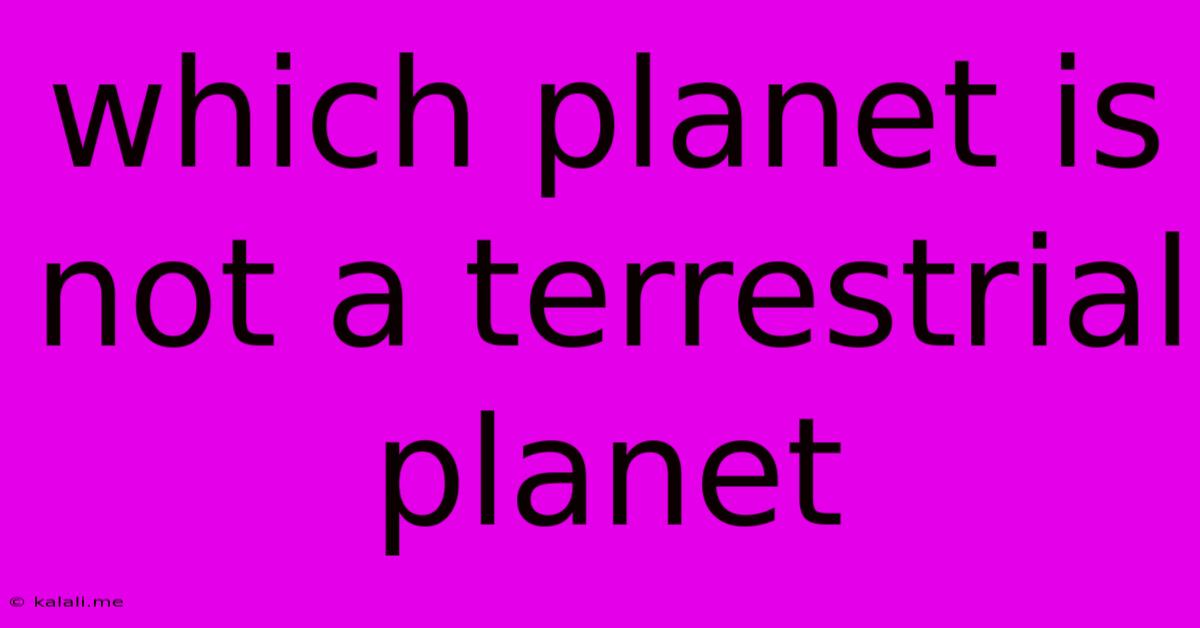Which Planet Is Not A Terrestrial Planet
Kalali
Jun 14, 2025 · 2 min read

Table of Contents
Which Planet is Not a Terrestrial Planet? Understanding Planetary Classification
This article will explore the classification of planets in our solar system, focusing specifically on terrestrial planets and identifying the planet that doesn't fit this category. Understanding the characteristics that define terrestrial planets is key to grasping the vast differences in planetary composition and formation within our solar system. We'll delve into the defining features of terrestrial planets and highlight why one particular planet stands out as distinctly different.
Terrestrial planets, also known as inner, rocky planets, are characterized by their solid, rocky surfaces, relatively small sizes, and high densities. They are primarily composed of silicate rocks and metals. This is in stark contrast to the gas giants that dominate the outer solar system.
Defining Characteristics of Terrestrial Planets
Several key features distinguish terrestrial planets from other planetary types:
- Solid Surface: Terrestrial planets possess a solid, rocky crust, unlike the gas giants which are primarily composed of gas and liquid.
- High Density: Their high density is a result of their composition, primarily consisting of heavy elements like silicon, oxygen, iron, and magnesium.
- Smaller Size: Compared to the gas giants, terrestrial planets are significantly smaller in both diameter and mass.
- Few or No Moons: Terrestrial planets generally have few or no moons, compared to the gas giants that often possess numerous moons.
- Thin or No Atmosphere: While some terrestrial planets have atmospheres, they are typically thinner and less substantial than those of the gas giants.
The Non-Terrestrial Planet: Jupiter
Of the eight planets in our solar system, Jupiter is clearly not a terrestrial planet. It dramatically differs in its composition, size, and overall characteristics. Jupiter is a gas giant, primarily composed of hydrogen and helium. It lacks a solid surface, its atmosphere extending deep into its interior.
Jupiter's immense size dwarfs all the terrestrial planets; it's over 300 times more massive than Earth. Its low density is another key difference, further solidifying its distinct nature from the rocky, dense terrestrial planets. Its massive gravity allows it to retain a thick, extensive atmosphere, unlike the thinner atmospheres of the terrestrial planets. Its numerous moons are another significant distinction.
Other Gas Giants and Their Similarities to Jupiter
The other gas giants in our solar system, Saturn, Uranus, and Neptune, share similar characteristics with Jupiter, distinguishing them from the terrestrial planets. They are all significantly larger than the terrestrial planets, have low densities, and lack a solid surface. Their composition also largely consists of hydrogen and helium, with traces of other gases and ice.
In Conclusion
In summary, while Mercury, Venus, Earth, and Mars are all categorized as terrestrial planets due to their shared features, Jupiter stands out as the clear exception. Its gaseous composition, massive size, and low density clearly distinguish it from the rocky, inner planets. Understanding these planetary classifications provides valuable insight into the diverse formation and evolution processes within our solar system.
Latest Posts
Latest Posts
-
One Coulomb Equals How Many Electrons
Jun 14, 2025
-
In A School Containing 360 Students
Jun 14, 2025
-
Which Of The Following Is Not A Type Of Joint
Jun 14, 2025
-
A Small River That Joins A Larger River Is A
Jun 14, 2025
-
Which Of The Following Are Mechanical Waves
Jun 14, 2025
Related Post
Thank you for visiting our website which covers about Which Planet Is Not A Terrestrial Planet . We hope the information provided has been useful to you. Feel free to contact us if you have any questions or need further assistance. See you next time and don't miss to bookmark.